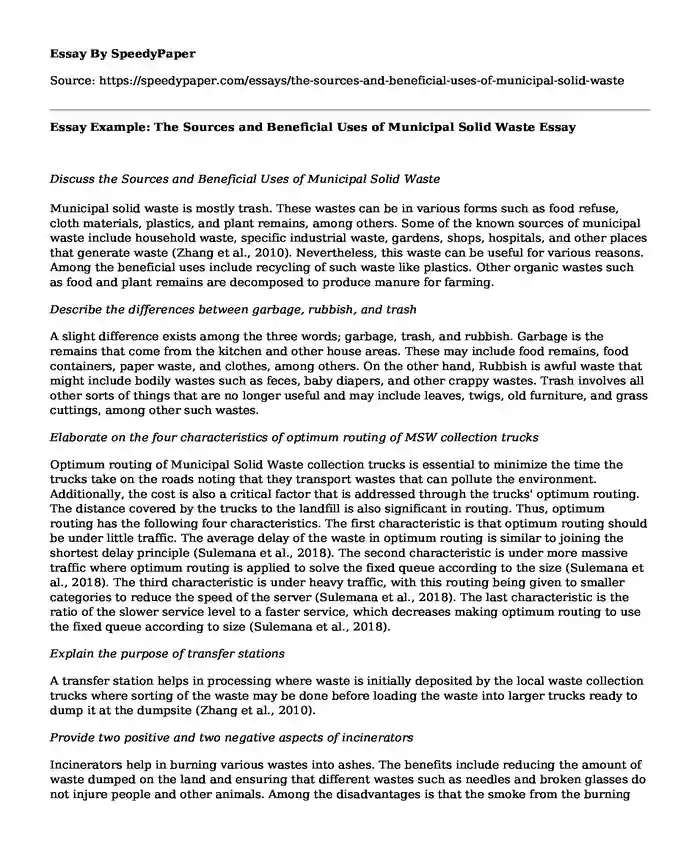Discuss the Sources and Beneficial Uses of Municipal Solid Waste
Municipal solid waste is mostly trash. These wastes can be in various forms such as food refuse, cloth materials, plastics, and plant remains, among others. Some of the known sources of municipal waste include household waste, specific industrial waste, gardens, shops, hospitals, and other places that generate waste (Zhang et al., 2010). Nevertheless, this waste can be useful for various reasons. Among the beneficial uses include recycling of such waste like plastics. Other organic wastes such as food and plant remains are decomposed to produce manure for farming.
Describe the differences between garbage, rubbish, and trash
A slight difference exists among the three words; garbage, trash, and rubbish. Garbage is the remains that come from the kitchen and other house areas. These may include food remains, food containers, paper waste, and clothes, among others. On the other hand, Rubbish is awful waste that might include bodily wastes such as feces, baby diapers, and other crappy wastes. Trash involves all other sorts of things that are no longer useful and may include leaves, twigs, old furniture, and grass cuttings, among other such wastes.
Elaborate on the four characteristics of optimum routing of MSW collection trucks
Optimum routing of Municipal Solid Waste collection trucks is essential to minimize the time the trucks take on the roads noting that they transport wastes that can pollute the environment. Additionally, the cost is also a critical factor that is addressed through the trucks' optimum routing. The distance covered by the trucks to the landfill is also significant in routing. Thus, optimum routing has the following four characteristics. The first characteristic is that optimum routing should be under little traffic. The average delay of the waste in optimum routing is similar to joining the shortest delay principle (Sulemana et al., 2018). The second characteristic is under more massive traffic where optimum routing is applied to solve the fixed queue according to the size (Sulemana et al., 2018). The third characteristic is under heavy traffic, with this routing being given to smaller categories to reduce the speed of the server (Sulemana et al., 2018). The last characteristic is the ratio of the slower service level to a faster service, which decreases making optimum routing to use the fixed queue according to size (Sulemana et al., 2018).
Explain the purpose of transfer stations
A transfer station helps in processing where waste is initially deposited by the local waste collection trucks where sorting of the waste may be done before loading the waste into larger trucks ready to dump it at the dumpsite (Zhang et al., 2010).
Provide two positive and two negative aspects of incinerators
Incinerators help in burning various wastes into ashes. The benefits include reducing the amount of waste dumped on the land and ensuring that different wastes such as needles and broken glasses do not injure people and other animals. Among the disadvantages is that the smoke from the burning waste pollutes the air. Additionally, using an incinerator might be expensive as installing one requires a lot of money, and not everyone can afford it.
Describe the purpose of composting
Composting allows organic wastes to decompose, which is later used and sold as manure to farmers to help in their agriculture. It also helps reduce the organic wastes that might end up in the wrong places.
Discuss four differences between dumps and landfills
A dump is a hallowed area of land where waste is stored while a landfill is a land excavated as well for waste disposal but regulated by authorities. Secondly, a landfill is vast than a dump. Thirdly, there is no treatment of waste in dumps, unlike in landfills. Finally, landfills are covered with soil, unlike dumps.
Address the following question: If each person in a city of 20,000 people generates 5 pounds per day of MSW, how many pounds of MSW is generated in a year in the city? 20000×5pounds=100000pounds per day, therefore, waste per year will be, 100000pounds×12=1200000pounds of waste per year
Address the following question: In a different city, if the landfill volume required per year is 300,000 m3, and the average fill depth is 15 m, what is the required landfill area (m2) per year? 300000m3÷15m=20000m2
References
Sulemana, A., Donkor, E. A., Forkuo, E. K., & Oduro-Kwarteng, S. (2018). Optimal routing of solid waste collection trucks: A review of methods. Journal of Engineering, 2018.
Zhang, D. Q., Tan, S. K., & Gersberg, R. M. (2010). Municipal solid waste management in China: status, problems and challenges. Journal of Environmental Management, 91(8), 1623-1633.
Cite this page
Essay Example: The Sources and Beneficial Uses of Municipal Solid Waste. (2023, Nov 14). Retrieved from https://speedypaper.net/essays/the-sources-and-beneficial-uses-of-municipal-solid-waste
Request Removal
If you are the original author of this essay and no longer wish to have it published on the SpeedyPaper website, please click below to request its removal:
- The Global Economy Reserach, Free Essay Sample for Students
- Essay Sample Focusing on the Impacts of Climate Change on Wheat Production
- Annotated Bibliography Paper Sample: Environmental Literature Searches
- Essay Example on Ecosystem and Restoration Ecology Effects
- What is the Clean Air Act? Paper Example
- Essay Sample on Water Pollution on Aquatic Life
- The Environment Impacts on Our Lives - Paper Example
Popular categories





